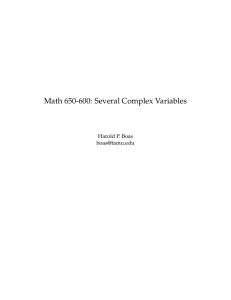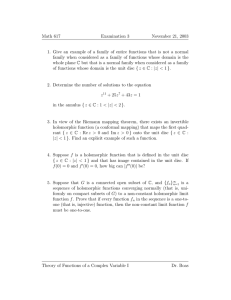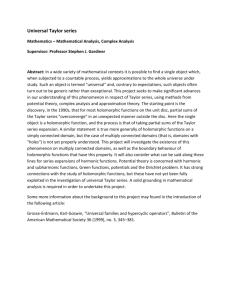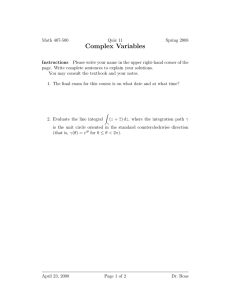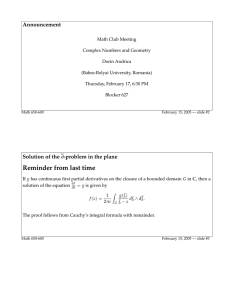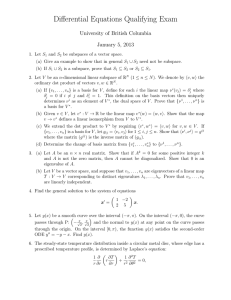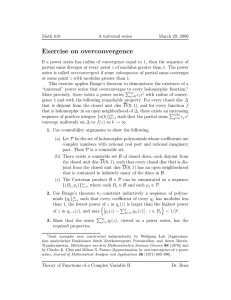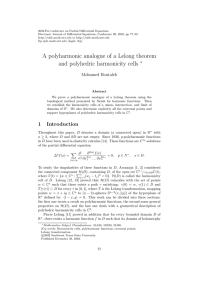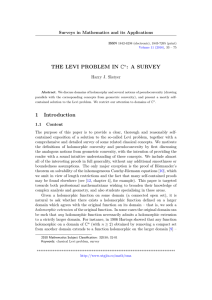Math 650-600: Several Complex Variables Harold P. Boas
advertisement
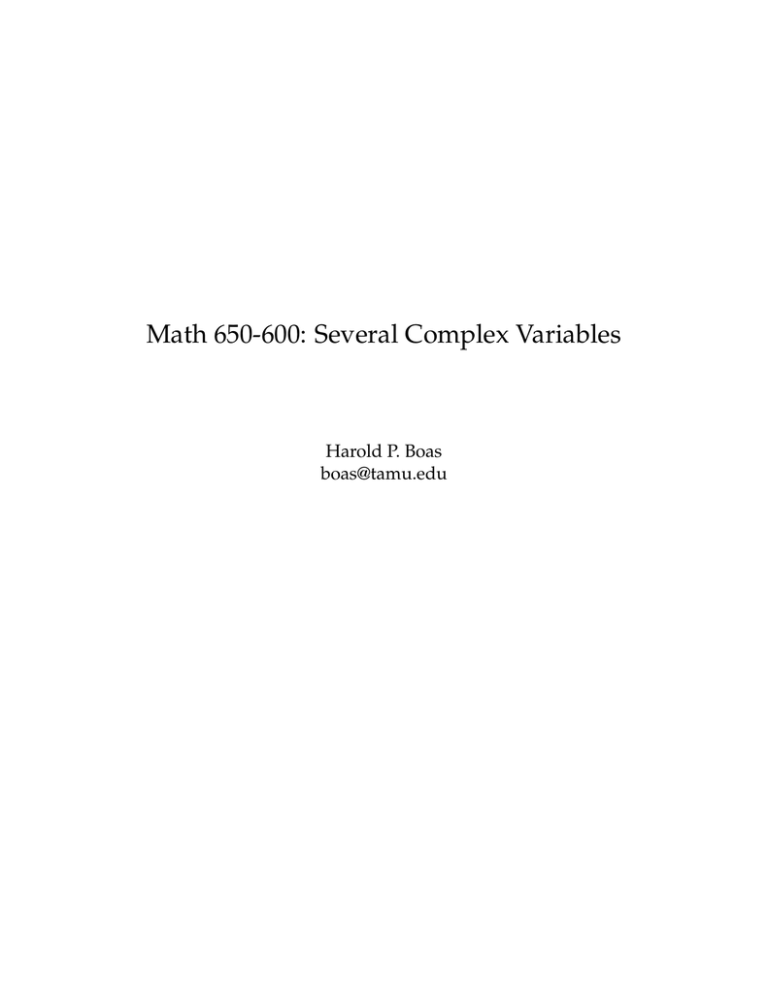
Math 650-600: Several Complex Variables
Harold P. Boas
boas@tamu.edu
Taylor expansion
If ρ is a real-valued class C 2 function, then
n
n
∂ρ
∂2 ρ
ρ(z) = ρ(0) + 2 Re ∑
(0)z j zk
(0)z j + Re ∑
∂z j
∂z j ∂zk
j=1
j,k=1
n
+
∂2 ρ
∑ ∂z j ∂zk (0)z j zk + o(|z|2 ).
j,k=1
Suppose ρ is a defining function for a domain, and 0 is a boundary point. Choose coordinates
such that Re zn is normal at 0. The Taylor expansion reduces (possibly after rescaling) to
ρ(z) = Re zn + Re
n
∂2 ρ
∂2 ρ
(0)z
z
+
∑ ∂z j ∂zk j k ∑ ∂z j ∂zk (0)z j zk + o(|z|2 ).
j,k=1
j,k=1
n
Math 650-600
April 12, 2005 — slide #2
Consequences of a negative eigenvalue
∂2 ρ
Now zn 7→ zn + ∑nj,k=1 ∂z ∂z (0)z j zk is a holomorphic change of variables that further reduces
j k
the Taylor expansion to
n
∂2 ρ
(0)z j zk + o(|z|2 ).
ρ(z) = Re zn + ∑
∂z
∂z
j k
j,k=1
Suppose the Levi form at 0 is negative in some complex tangential direction, say z 1 . Then
ρ(λ, 0, . . . , 0) < 0 when λ is a non-zero complex number of modulus less than some e.
Thus the analytic disc { (λ, 0, . . . , 0) : |λ| < e } is contained in Ω except for the center point,
which lies on the boundary. Translating the disc in the direction of decreasing Re z n moves the
disc inside Ω, so the continuity principle is violated.
Translating the disc in the direction of increasing Re z n gives a way to extend all holomorphic
functions across the boundary by using the Cauchy integral.
Math 650-600
April 12, 2005 — slide #3
Exercise on Reinhardt domains
For a complete Reinhardt domain in C2 with smooth boundary, show that the Levi form is ≥ 0
if and only if the domain is logarithmically convex.
This solves a special case of the Levi problem.
The next exercise solves another special case of the Levi problem.
Math 650-600
April 12, 2005 — slide #4
Exercise on tube domains
An unbounded domain Ω in Cn is called a tube domain with base G in Rn if Ω = { x + iy ∈
Cn : x ∈ G and y ∈ Rn }.
Exercise. Show that a tube domain in Cn is pseudoconvex if and only if the base G in R n is
convex.
References: Pierre Lelong, La convexité et les fonctions analytiques de plusieurs variables complexes, Journal de
Mathématiques Pures et Appliquées (9) 31 (1952) 191–219; H. J. Bremermann, Complex convexity, Transactions of the
American Mathematical Society 82 (1956) 17–51.
Pierre Lelong
Hans-Joachim Bremermann
born 14 March 1912
Math 650-600
1926–1996
April 12, 2005 — slide #5
Complete Hartogs domains
A complete Hartogs domain Ω in Cn+1 with base G in Cn is defined by |zn+1 | < e−u(z1 ,...,zn ) for
(z1 , . . . , zn ) ∈ G, where u is upper semi-continuous.
Theorem. A complete Hartogs domain is pseudoconvex if and only if (a) the base is pseudoconvex and (b) the function u is plurisubharmonic.
Proof. If Ω is pseudoconvex, then there is a plurisubharmonic exhaustion function. Restrict the
function to the base to get a plurisubharmonic exhaustion function on G. So (a) holds.
If c = (0, 0, . . . , 0, 1), then − log d c (z1 , . . . , zn , 0) = u(z1 , . . . , zn ). From a previous proof, we
know that pseudoconvexity of Ω implies plurisubharmonicity of − log d c . So (b) holds.
The converse will be done next time.
Math 650-600
April 12, 2005 — slide #6

